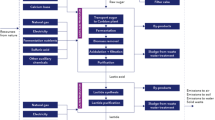Abstract
Purpose
This study aims to assess the environmental impacts of liquified natural gas (LNG) process production, identify the increasing potential of environmental performance, publish environmental product declarations, and contribute to a national database of environmental impacts.
Methods
The analysis scope covers raw material receiving, a liquefaction process, utility, and storage and loading of the product. The assessed impacts are categorized as primary, secondary, and energy usage impacts using a life cycle assessment method that refers to ISO 14040-2016 and ISO 14044-2017 guidelines. The three methods for impact evaluation included ReCiPe 2016 Midpoint (H) v.1.03, CML-IA Baseline v.3.05, and cumulative energy demand (CED) methods.
Results
Every ton of LNG product produced global warming, ozone depletion, acidification, and eutrophication potential of 699.31 kg CO2-eq, 2.62 × 10−4 kg CFC11-eq, 0.4281 kg SO2-eq, and 0.1155 kg PO4-eq, respectively. The secondary impact of the photochemical oxidant was 0.81968 kg C2H4-eq/ton. Abiotic depletion potential–fossil was observed at 23.41183 MJ/ton, while non-fossil was 0.0000041 kg Sb-eq/ton. Biotic depletion potential included terrestrial, freshwater, and marine ecotoxicity produced 3.0439 kg 1,4-DCB-eq/ton, 0.0452 kg 1,4-DCB-eq/ton, and 0.0630 kg 1,4-DCB-eq/ton, respectively. Carcinogenic and toxicity impacts produced 0.0681 kg 1,4-DCB-eq/ton and 1.966 kg 1,4-DCB-eq/ton. The impact on the water footprint of every ton of LNG was at 2.6387 m3, and land use change was evaluated at 0.0883 m3a corp-eq. Analysis of cumulative energy demand identified that the LNG plant needs only non-renewable energy. The specific energy consumption is 29,151.056 MJ/ton.
Conclusions
This study identified that the hotspots included the steam generation unit in Utility II and sour gas absorption in all studied trains. Steam generation produces more CO2, NOx, and SOx emissions. Besides, the utility applied phosphate and boiler feed water. The process of sour gas adsorption needs electricity and polydimethylsiloxane as an adsorbent.







Similar content being viewed by others
Data availability
The datasets generated during the current study are available from the corresponding author upon reasonable request.
References
Arteconi A, Brandoni C, Evangelista D, Polonara F (2010) Life-cycle greenhouse gas analysis of LNG as a heavy vehicle fuel in Europe. Appl Energy 87(6):2005–2013. https://doi.org/10.1016/j.apenergy.2009.11.012
Bare JC, Hofstetter P, Pennington DW, De Haes HA (200) State-of-the-art state-of-the-art: LCIA midpoints versus endpoints: the sacrifices and benefits. Int J Life Cycle Assess 5(6):319–326. Available: https://doi.org/10.1007/BF02978665
Di Lullo G, Oni AO, Gemechu E, Kumar A (2020) Developing a greenhouse gas life cycle assessment framework for natural gas transmission pipelines. J Nat Gas Sci Eng 75(January):103136. https://doi.org/10.1016/j.jngse.2019.103136
Dong Y, Rosenbaum RK, Hauschild MZ (2018) Metal toxicity characterization factors for marine ecosystems—considering the importance of the estuary for freshwater emissions. Int J Life Cycle Assess 23(8):1641–1653. https://doi.org/10.1007/s11367-017-1376-x
Hönig V, Prochazka P, Obergruber M, Smutka L, Kucerová V (2019) Economic and technological analysis of commercial LNG production in the EU. Energies 12(8):1–17. https://doi.org/10.3390/en12081565
Huijbregts MAJ et al (2017) ReCiPe2016: a harmonized life cycle impact assessment method at midpoint and endpoint level. Int J Life Cycle Assess 22(2):138–147. https://doi.org/10.1007/s11367-016-1246-y
Li J et al (2021) Life cycle assessment of liquefied natural gas production from coke oven gas in China. J Clean Prod 329(October):129609. https://doi.org/10.1016/j.jclepro.2021.129609
Munagala M, Shastri Y, Nalawade K, Konde K, Patil S (2021) Life cycle and economic assessment of sugarcane bagasse valorization to lactic acid. Waste Manag 126:52–64. https://doi.org/10.1016/j.wasman.2021.02.052
Ren X, Ren J, Deng M (2012) Poly(amide-6-b-ethylene oxide) membranes for sour gas separation. Sep Purif Technol 89:1–8. https://doi.org/10.1016/j.seppur.2012.01.004
The Presidential Decree of the Republik of Indonesia No. 98 (2021) Implementation of Carbon Economic Value for Achieving National Contribution Targets and Controlling Greenhouse Gas Emissions in National Development: 1-68
The Regulation of the Minister of Environment and Forestry of the Republic of Indonesia Number 1 (2021) The Company Performance Rating Assessment Program in Environmental Management: 1–312
Castán Broto V (2018) Natural gas and climate finance. Clim Policy 18(2):170–183. https://doi.org/10.1080/14693062.2016.1264357
Klinglmair M, Sala S, Brandão M (2014) Assessing resource depletion in LCA: a review of methods and methodological issues. Int J Life Cycle Assess 19(3):580–592. https://doi.org/10.1007/s11367-013-0650-9
Singh A, Agrawal M (2008) Acid rain and its ecological consequences. J Environ Biol 29(1):15–24
The Regulation of the Ministry of Industry of the Republic of Indonesia Number 1/M-IND/PER/6/2015 (2015) Guidelines for the Preparation of Standards of Green Industry: 1–26
Luke L, Noble B (2019) Consideration and influence of climate change in environmental assessment: an analysis of British Columbia’s liquid natural gas sector. Impact Assess Proj Apprais 37(5):371–381. https://doi.org/10.1080/14615517.2018.1533515
Pratama BS et al (2018) Neraca Gas Bumi Indonesia. Directorate General of Oil and Gas at the Ministry of Energy and Mineral Resources of the Republic of Indonesia: 1–70
Yuan X, Zhang B, Liang R, Wang R, Sun Y (2020) Environmental impact of the natural gas liquefaction process: an example from China. Appl Sci 10(5). https://doi.org/10.3390/app10051701
Acknowledgements
This study is related to the PROPER 2021 Program of PT Badak NGL from the Ministry of Environmental and Forestry of Republic of Indonesia. The authors gratefully acknowledge Elvin N Nadhifatin and Ridha C Rachmani from PT ITS Tekno Sains as external practitioners. Our appreciation goes to Che Hafizan, Aditya P Iswara, and Ahmad E Afiuddin for their critical reviews.
Funding
This work was supported by PT Badak NGL-Republic of Indonesia.
Author information
Authors and Affiliations
Corresponding author
Ethics declarations
Competing interests
The authors declare no competing interests.
Additional information
Communicated by Guido W. Sonnemann.
Publisher's Note
Springer Nature remains neutral with regard to jurisdictional claims in published maps and institutional affiliations.
Rights and permissions
Springer Nature or its licensor (e.g. a society or other partner) holds exclusive rights to this article under a publishing agreement with the author(s) or other rightsholder(s); author self-archiving of the accepted manuscript version of this article is solely governed by the terms of such publishing agreement and applicable law.
About this article
Cite this article
Benarimo, S., Lukito, E., Adnan, M.A. et al. Life cycle assessment on improvement strategies of environmental sustainability for a liquified natural gas plant in Indonesia. Int J Life Cycle Assess 28, 1142–1154 (2023). https://doi.org/10.1007/s11367-023-02191-9
Received:
Accepted:
Published:
Issue Date:
DOI: https://doi.org/10.1007/s11367-023-02191-9




